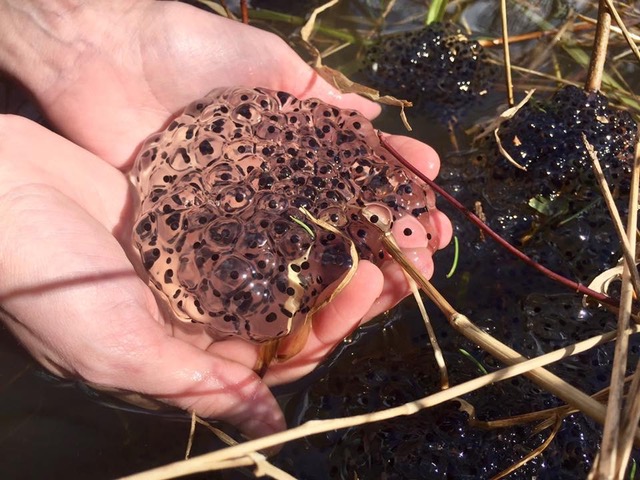Research underscores importance of cold-temperature variability in evaluating climate change

BINGHAMTON, NY – New research from Binghamton University, State University of New York, highlights the importance of considering cold temperature variability, and not just warming temperatures, when evaluating the impact of climate change.
A team of Binghamton University researchers including Jessica Hua, assistant professor of biological sciences, and George Meindl, assistant professor of environmental studies, investigated the effect of climate change on amphibian health and their susceptibility to contaminants and parasites. When it comes to climate change, public attention often focuses on the effect of rising average temperatures. In contrast, this study focused on the effect of cold and variable temperatures, which are also consequences of climate change. The researchers discovered that cold temperatures make amphibians more susceptible to road salt but less susceptible to parasites. These findings reveal the importance of considering cold-temperature variability, and not just warming temperatures, when evaluating the impacts of global climate disruption, said Hua.
“There is a lot of misconception that global climate change only refers to an increase in warming temperatures,” Hua said. “We feel that the research in this paper is important because it highlights that global climate change is more complex than just an increase in average temperature. In fact, global climate change is also predicted to increase the prevalence of extreme cold temperature events, as well as increase the amount of variation in temperature fluctuations.”
Lead author Matthew Wersebe from the University of Oklahoma agreed and said that many people overlook the impact of climate change on plants and animals.
“We all recognize that climate change [is] one of the most serious issues facing us today,” said Wersebe. “However, as much as it is recognized as [a] serious concern for people, the impacts to animal and plant populations is much less front and center. Along with this, many studies only consider warming, or changing patterns of water availability on natural systems, and not the impact of the variability in the short-term that is also expected with climate change. Studies like these are critical to understanding the full impacts of climate change.”
Due to the rising temperatures from climate change, organisms begin breeding earlier in the spring, which paradoxically leads to an increased risk that these organisms are exposed to heightened fluctuations in temperature during early development, including harmful cold-temperature regimes. It is important to note that while these cold temperatures may not always be deadly, they may alter the susceptibility of amphibians to other stressors, including contaminants and parasites. By placing wood frog embryos in various cold temperature regimes, researchers looked specifically at the consequences of exposure to these lower temperatures.
The research team discovered that amphibians exposed to constant cold conditions as embryos were more susceptible to road salt contamination, but were able to recover as they aged. This is particularly relevant as road salt use is predicted to increase during extreme cold temperature events. The team also found that amphibians exposed to cold temperatures as embryos were generally smaller as they aged, and developed slower, which ultimately made them less prone to parasites because their miniature size made them less attractive. However, these results were not anticipated.
“We initially predicted that exposure to cold temperatures would be stressful to developing embryos. As a consequence, we expected that exposure to stressful conditions early in life would make amphibians less able to deal with other stressors later in life (i.e. parasites),” Hua said. “We were also surprised because past studies have found that cooler temperatures can increase amphibian susceptibility to another parasite (the fungus, chytrid). In this case, the negative effects of the cooler temperatures on amphibians are driven by the fact that the fungus survived better in cooler temperatures.”
Ultimately, the study concluded that variation in cold temperatures can lead to unique consequences on amphibian growth, development and responses to other stressors, such as contaminants and parasites. Whether the impact from the cold was harmful or helpful for the amphibians is difficult to gauge.
“In some cases, exposure to cold temperatures was harmful. For instance: exposure to cold temperatures during the egg phase made young tadpoles more susceptible to road salt,” said Wersebe. “However, if we allowed these tadpoles to grow older, we found that exposure to cold temperatures during the egg stage no longer mattered for their susceptibility to road salt (i.e. older tadpoles were able to overcome the negative effect of embryonic exposure to cold). Exposure to cold also made amphibians smaller—this is potentially harmful to amphibian populations because smaller amphibians have fewer offspring and this can over time potentially contribute to populations declines. Amphibian populations are declining globally, so considering the effects of cold temperatures may be important in understanding how to protect this imperiled group of animals.”
With further research, Hua hopes to test other amphibian species and look closer at why cold temperatures make amphibians more susceptible to salt during their egg phase.
Contributing to this research were former and current Binghamton University students in the Hua lab: Matthew Wersebe (now at University of Oklahoma), Paradyse Blackwood, Ying Tong Guo, Jared Jaeger (now at Rensselaer Polytechnic Institute), Dyllan May, Sean Ryan (now at University of Connecticut), and Vivian Wong.
The paper, “The effects of different cold-temperature regimes on development, growth, and susceptibility to an abiotic and biotic stressor,” was published in Ecology and Evolution.

